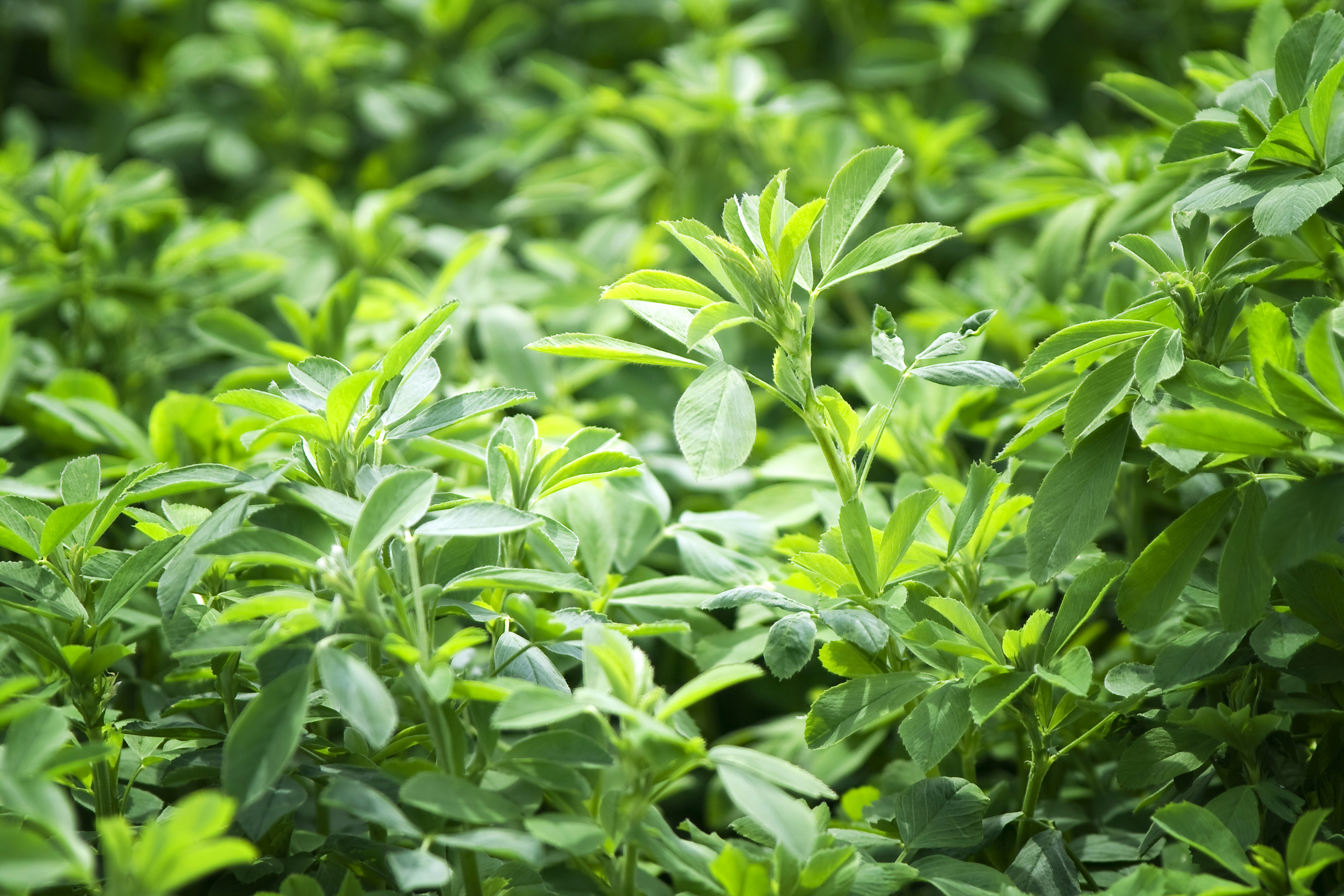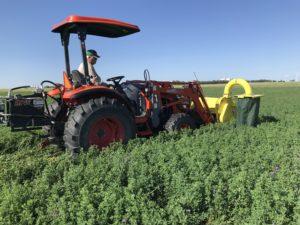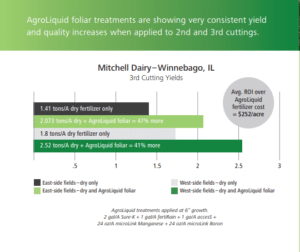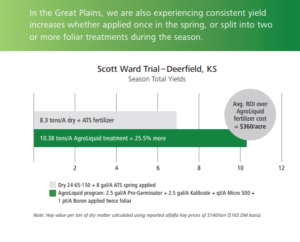The subject of forage quality and its relationship to cow health and milk yield is a fascinating, yet highly complex subject. What are the factors involved in producing high quality forage? And how does this translate to milk production? Let’s take a look at how to improve milk production, forage quality, and digestibility, and the role that nutrients play in that equation.
Why are Forages Important?
When the acres of pasture, grass hay, alfalfa, corn and sorghum silages, and grazing wheat in the plains are all added up, forages account for by far the most acreage of any US crop. In fact, land used for grazing is over 780 million acres – equal to 40% of the entire land area of the US and nearly double the land used for other crops of all types. Add to that the 61 million acres of alfalfa, 15 million for corn and sorghum silages, then add in the grass hays and others, and you can see that forages comprise the vast majority of US cropland.
Yet, it could be said that forages continue to be neglected when it comes to fertilization. The majority of grazing lands receive no fertilizer of any kind, with the resulting low forage yield/lower daily rate of gain being widely accepted on land with low perceived value. At AgroLiquid, however, we are discovering that even a very modest rate of our products applied at the right time results in a large return on investment.
Why Alfalfa?

Although there is growing interest in alternative forages such as annual grass/small grain blends with annual legumes and other forbs, alfalfa is still the “Queen” of forages (corn silage is “King”).
There are many reasons for this, including alfalfa’s unparalleled animal nutrition profile. Good quality alfalfa cut at the right time will contain 20% or more of crude protein – the highest of the popular forage crops. This protein is highly soluble with a great balance of amino acids.
Alfalfa contains vitamins such as A, E, K, D, B1, C, B2, B12, U, B6 and amino acids such as folic acid, panthothanic acid, biotin, niacin and inocitole. In addition to these, alfalfa has high levels of calcium (Ca), potassium (K), phosphorus (P), sulfur (S), copper, chlorine, magnesium, iron, boron, manganese and cobalt.
Other benefits from alfalfa in the ruminant diet include:
- Highly degradable protein, up to 74-79% according to some estimates.
- Its digestibility reduces the amount of cud a cow must chew.
- It increases rumen buffering.
- It promotes faster digestion of digestible fiber.
- Cows will often eat more alfalfa than grass because the fiber content is usually lower in well managed alfalfa.
Why Fertilize Forages?
Why fertilize alfalfa? Some reasons would likely include increasing or maintaining yield or avoiding “mining” the soil.
Another reason is the digestibility of a ration’s forage component has a large impact on a cow’s milk production. That is why cut timing is carefully managed, weather conditions are closely monitored, weeds and insects are controlled, and the bunks are filled and packed quickly. Recently, the dairy industry is also paying more attention to alfalfa fiber digestibility. Our researchers have also taken a closer look at alfalfa’s digestibility and how this impacts forage quality and milk yields. Through our research, we’ve found methods to improve alfalfa digestibility, which in turns improve milk production.
Learn more about optimizing fertilizer programs for alfalfa and milk production
Talk with our agronomists today
Why is Digestibility in Forages Important?
AgroLiquid is actively researching how fertilization practices influence forage digestibility and quality. Why digestibility?
Think of a cow as a milk “factory”. The primary factor that limits production is how much “raw material” the factory can process each day. So, for example, if our “milk factory” can consume a maximum of 85 pounds of feed per day, the amount of energy and nutrients contained within that 85 pounds that the cow is able to extract and utilize is what determines how much milk that cow can produce.
Differences in the amount of energy extracted (how digestible the feed is) directly correlates to the amount of milk that factory will produce. Why not just feed the very highest energy feeds possible – grain and fats? The answer is that cows are ruminants, having multiple “stomachs”. Their digestive system uses bacteria and enzymes to digest fibrous plant material. For their digestive system to work properly, it must have large amounts of digestible and indigestible fiber. Fats (like vegetable oils) largely pass through this system undigested. This system is also limited to how much non-fibrous concentrate (grains) it can handle.
Why is alfalfa so important as a dairy cow forage? The reasons include its overall yield, higher digestible energy content compared with grasses, its high levels of usable protein, and its mineral nutrient content including the critically important calcium (why milk is a great source of dietary calcium).
Increasing Yields and Digestibility

All of the meat and milk animals that consume forages are, in fact, designed to consume forages – not grains. So even though we do supplement ruminant animal diets with grain, these animals must still have forage as a major component of their diets. Normally when a grower or agronomist is asked why we fertilize forages, the answer will be to obtain higher yields. While that is important, what if we could actually increase the quality and digestibility while at the same time increasing yield?
We can, in fact, increase yields and at the same time increase the digestibility and energy content of forage crops. In our trials, here is what we are discovering:
- We increase the sugars, protein, and palatability in grass hays, and the actual Neutral Detergent Fiber (NDFD) digestibility also improves substantially.
- On alfalfa we routinely achieve an increase in protein, lower lignin, higher water soluble carbohydrates (sugars), significantly higher Relative Feed Value (RFV) and Relative Forage Quality (RFQ) numbers, higher NDFD tests, and more extractable net energy.
- On permanent grass pastures we see strong yield and quality responses to low and economical rates of High NRG-N, Pro-Germinator, Sure-K, and fertiRain.
Potassium in Forage Digestibility
Of the three macronutrients, nitrogen (N), phosphorous (P), and potassium (K), potassium may the least understood in how it influences forage digestibility. Potassium plays a large role in the yield and quality of forage crops. Potassium plays a key role in the photosynthesis, respiration, translocation and many enzyme systems in plants, and also increases disease resistance. For alfalfa, potassium is a dichotomy of sorts. It strongly influences yield, but only to a point – I will discuss that in greater length later in this article. Other ways it is important include improving the level of carbohydrates stored in alfalfa roots. Greater stand persistence is a result.
“Milk Fever” and the Nutrients in Forages
Maximum alfalfa yields are usually reached with potassium concentrations in midstem samples of 1.25 to 1.75% and in the top six inches of the plant of 2.0 to 2.5%. Higher concentrations are undesirable in alfalfa because it reduces calcium and other element concentrations, thereby adversely affecting the cow’s utilization of the forage and increasing the occurrence of “milk fever” after calving (an acute deficiency of blood calcium).
The way it happens is this: As dairy cows enter the lactation stage “freshening” prior to calving, large amounts of calcium leave the cow’s blood and enter the milk she is now producing faster than it can be replaced. This decreased calcium concentration in the blood lowers the blood pH, causing nerve disorders, muscle weakness, loss of appetite, paralysis, and subsequent death if not treated immediately.
The rations for freshening cows should therefore be relatively anionic (lower in potassium) in the month prior to calving to raise blood calcium levels. But, having a steadily available supply of lower potassium alfalfa is difficult because producers often fertilize for high forage yields with potassium chloride fertilizer without regard to actual soil test levels, and in trying to maximize alfalfa yields. Through soil testing, lower potassium concentrations in forages are possible by avoiding building soil potassium to higher levels than necessary and using careful fertilization practices.
Potassium Chloride and Chloride Toxicity
The most common source of potassium fertilizer is potassium chloride, a pure salt. It’s well known that high rates of potassium chloride often create a chloride toxicity, particularly where significant soil chloride levels are already present, which is often the case where manure is spread.
Excess chloride can also reduce plants’ uptake of other vital nutrients like nitrogen, sulfur, phosphorus, boron and others, which often takes a heavy toll on yields and forage quality. The very high salt of potassium chloride can also lead to reduced soil microbiological activity and poor germination of new seeding.
Potassium Exits; Chloride Remains
According to David Weber writing in the Progressive Dairyman, “Particularly in fresh cows, research shows how alarming forages high in chloride can be for performance and health. In fact increasing levels of chloride in lactating diets has a negative effect on feed intake and milk production. To avoid these pitfalls, diets must be formulated to account for the variability in forage chloride levels to optimize milk production. Chloride is continually recycled on the dairy. Potassium exits the farm in many avenues, including in the milk. Chloride, though, is left behind in manure and applied back onto the fields. The rising chloride levels and the continuous potassium chloride fertilization have resulted in extreme forage variability in macromineral levels.”
Weber found that some forages had chloride levels over 1 percent of ration dry matter, which negatively affects lactating cow performance and health. To account for the chloride being regularly applied through potassium chloride fertilizer, routine chlorine testing in all forages is advised. This information will allow ration formulation to meet cows’ needs.
Does Digestibility Increase Value?
What is the value to the beef cow/calf, feedlot manager, or dairyman for quality and digestibility improvement in their forages – even their low value forages such as “grinder hay”?
Here are some interesting numbers as an example: Every one whole number increase in the alfalfa NDFD test increases milk production by a half pound more milk per day. We often see an eight point increase in the NDFD score in alfalfa treated with a foliar AgroLiquid program. So if we were feeding a ration with 100% of that alfalfa, the cows would produce four pounds more milk per cow per day.
However, in real life, alfalfa is fed at an average of closer to 25% of the total mixed ration on large dairies. If a dairy operation with 2,000 cows in lactation is feeding alfalfa at 25% of their total mixed ration here is how the math works: 4 pounds times 25% = 1 more pound of milk per cow per day. On this dairy that’s 2,000 more pounds per day.
Milk is priced per hundred weight, so that’s 20 more pricing units per day times current “mailbox” price of $18 (varies by state) = $360 more per day = $131,400 more per year. In this example, based on a real operation, their extra cost was $15,000 per year (replacing a portion of their standard dry program) which netted them $116,400.
Alfalfa Fertilizers and Improved Digestibility, Forage Quality, and Value
One significant factor we are learning in our many trials is that when individual AgroLiquid products replace the comparable commodity fertilizer product, it will, in most situations, improve the forage quality.
For example, if Pro-Germinator replaces 11-52-0 on a grass pasture, the quality of the grass will be better. Likewise if Sure-K replaces or reduces dry potash, the forage treated with Sure-K will have better quality. Where High NRG-N has replaced urea or UAN, the resulting grass pasture or hay will have higher quality, a larger root mass, and more consistent growth.
Can an AgroLiquid program entirely replace a commodity dry program? Yes it can – but you may not always want to. For example, when we have tested yield and quality results where Sure-K is used as a supplemental foliar treatment following a top-dress application of dry potash, we usually see a significant increase in yield and quality versus the dry potash alone. So where soil test K is low, we can use dry potash and Sure-K to the grower’s advantage. On the high pH soils of the Central Plains, however, Pro-Germinator clearly performs better than 11-52-0, achieving both higher yields and improved forage quality, and should be recommended as full replacement for the dry.
Alfalfa Tonnage, Digestibility and Feed Quality Research
Let’s take a look at an example. AgroLiquid has studied these challenges and we have solutions to address not only the macronutrient needs of alfalfa, but also provide the essential secondary and micronutrients to bolster plant strength, reduce time between cuttings, and improve feed digestibility. This, in turn, has been shown to increase alfalfa tonnage, improve feed nutritional quality, and improve milk production as well as rate of gain.
Liquid Fertilizer for Alfalfa, Tonnage and Feed Quality Study
AgroLiquid’s alfalfa fertilizer program yielded:
- 40% more milk per acre
- 37% more yield per cutting
- 6% lower lignin
- 5% more protein
- 4 days quicker to maturity
Poplar Farms Alfalfa Quality Research with Optimized Fertilizer Program
Additional research was conducted at Poplar Farms Sales and Service near Manitowoc, WI, in cooperation with their Dairyland Seeds representative. They decided to split north/south an alfalfa variety plot which was planted east/west. The field split compared conventional dry potash top-dressed against AgroLiquid’s Sure-K applied foliar at 6”. They tested each variety on each treatment for quality and digestibility in addition to dry matter yield.
The results were significant, with markedly better Neutral Detergent Fiber Digestibility (NDFD), protein, Relative Feed Quality (RFQ), milk/ton and milk/acre on the Sure-K side. AgroLiquid Field Agronomy Manager for the upper Midwest, Dan Peterson, took note of these results and conducted an additional 11 alfalfa field and test plot trials across Michigan, Wisconsin, and Minnesota during 2016.
He discovered the results were indeed repeatable, with all 11 trials showing positive results for the AgroLiquid treatments versus the conventional fertilizer treatments. This level of repeatability is unusual in agronomic testing, and provides strong evidence that AgroLiquid foliar products are doing something unique in the plant, something that other liquid foliar and dry fertilizers are not doing.
The 11 field splits and test plots were across several different conventional dry and foliar treatments and were compared side-by-side to various AgroLiquid foliar treatments. The average of the results across all fields and cuttings showed remarkable results from the AgroLiquid treatments:
- 37.3% more dry matter/acre.
- 2.6 more lbs of milk/cow/day (per NDFD).
- Over 20% faster digestion rate (per the Dynamic NDF kd).
- 5% more protein.
- 40.5% more milk/acre.
The trials were from new seeding through 4th year stands, across different cuttings, soil types, soil fertility levels, and geographies. The AgroLiquid treatments were compared to conventional dry fertilizers, top-dress manure, and competing foliar products.
Although the results varied, in every trial the AgroLiquid treatment resulted in a large ROI over the other treatments. In addition, in every trial the AgroLiquid treated side reached maturity between cuttings three to five days quicker than the conventional fertilizer or manure side of the fields. This may allow an additional cutting for the season. Dairy producers who participated in these trials noted not only the faster regrowth but more and larger leaves and less of the typical leaf yellowing below the canopy.
The question is how do AgroLiquid’s plant nutrient products achieve these remarkable tonnage and digestibility improvements in alfalfa? The answer is their unique Nutriq Technology. The flavonol organic polymer facilitates better nutrient uptake and utilization within the plants with less metabolic energy expended. For more information on improving alfalfa quality and digestibility using optimized fertilizer programs, contact us.



